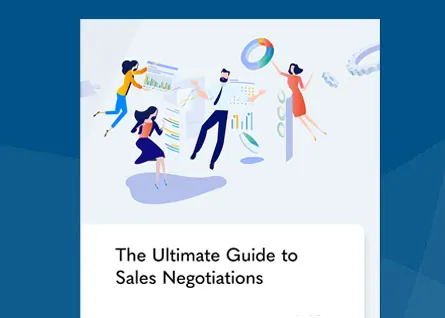6 Easy Steps to Get More Sales Referrals

On a scale of 1-10, how critical are referrals to your business? If you did not answer with a 10 you might want to think about this…
The Facts About Referrals: The average business spends 5x more on trying to acquire new business than on generating referrals from existing clients. However, referrals are 5x more valuable, they convert faster, they improve the credibility of your business, and they stay clients longer.
Does this data change your perspective on how critical referrals are to your business? If so, keep reading to learn how to generate referrals without overthinking it. In this article, we will outline why salespeople struggle with generating referrals, the solution, and six practical steps to generate more referrals starting today.
The Problem: If we all know how valuable referrals are and we know existing clients are already sold on your business, then why do most salespeople struggle to generate referrals?
The number one reason salespeople struggle generating referrals is they doubt the value they provide. This doubt creates an obstacle that either prevents the salesperson from asking in the first place or they ask in a half-hearted attempt. The ask goes something like this:
Salesperson: “Hi Mrs. Prospect, I hate to bother you, but I was just wondering if you could give me a referral to anyone you know who might be interested in our solution.”
Mrs. Prospect: “Hmmm… maybe…let me think about that and get back to you.”
Trying to generate referrals like this is awkward and self-defeating because this approach can make the client feel uncomfortable. Making current clients feel uncomfortable is never a good strategy. But that’s what happens without a formal referral process. This awkward and uncomfortable asking for a referral only has to happen once or twice before you will never ask for a referral again.
Because salespeople may not have received training on how to generate referrals they feel uncomfortable and give up. Their mindset becomes:
- I don’t want to bother my clients.
- I don’t want to embarrass myself.
- I don’t want to look desperate.
- The client will provide a referral when they are ready.
- I don’t want to lose this client by annoying them.
This is a self-defeating mindset and limits your team’s ability to generate referrals. When a salesperson has this limiting self-talk it’s a sign they have doubts about either the value they provide and/or the product.
News flash—part of the responsibility of every sales manager is to teach their salespeople how to help clients make decisions. Telling your salespeople to “Get more referrals” without coaching is like telling them to fly without wings—it’s not going to work. If your sales team is not consistently generating referrals from clients and instead view it as a problem, then treat it as a coaching opportunity.
Solution: Change your mindset. Instead of asking for referrals shift your mindset to “I’m going to earn the referral.” This mindset shift removes all doubt and generates value for both the salesperson and the client. So, the next time your sales managers ask you, “How did you generate those referrals?” respond with “I earned them.” One of the biggest mistakes you can make in sales or life is to ask for something you haven’t earned. Don’t do it.
Step One: Put your referral process in writing. This does not mean a yellow post-it note on your computer that says, “Don’t forget to ask for a referral.” Every company will have a unique process but having it in writing will demonstrate to all stakeholders that generating referrals is not just an expected part of the job description for salespeople, but part of the culture of the company.
Step Two: The referral process should start with all prospects before they become clients. For example, you could build into your presentation that, “80% of our current customers are referrals.” By planting the seed with prospects that your business is based on referrals you create credibility. Of course, you change the percentage to match your current referral rate but with a written process and a formal strategy, this number will grow over time.
Step Three: Ask for the easy yes first. The easy yes is a client testimonial. If a client is not comfortable providing a testimonial, they definitely will not be comfortable referring you to someone else. A referral can feel risky because the other party’s credibility is on the line. However, if the client provides a testimonial, they are more likely to provide a referral.
Step Four: Create opportunities to ask for a referral instead of waiting for opportunities. Most companies receive referrals by accident. If you want to create opportunities ask yourself this question, “Why should my client give me a referral?” If you can’t answer this simple question, neither can your client. Remember we are looking for opportunities where we delivered real value like, “I helped my client increase revenue by 10%,” not “because I bring them donuts on Friday.”
Step Five: Give before you take. Have you ever had someone reach out who was not a good fit? Of course. Instead of looking at this non-qualified lead as a waste of time, maybe a current client could serve them better. It’s called reciprocity and it’s rarely used in sales. Be sure it’s a real opportunity for your client before you refer, but this tactic delivers real value. There’s an old saying, “You are not a professional salesperson until you have turned down business you could have won.” If you give your client a referral first, you are more likely to receive a referral.
Step Six: Make it easy. This will look different depending on your company, but you don’t want your client to fill out this long-form just to get a $10 gift card in 4 weeks. In fact, you don’t want your client to have to think too hard. Instead, you prepare the copy and make it easy for your client to use it in an email or a LinkedIn message. You could put a link in your signature or a blurb on invoicing. Whatever you do, don’t make it a punishment for your clients to give you a referral. Dropbox went from a few thousand clients to millions by making it easy for clients to refer business.
Generating more referrals does not happen by accident. A strong referral process could contribute 50% or more of your revenue. A study by the Wharton School of Business reports the lifetime value of referred clients are twice a valuable. The study concluded, “An analysis of almost 10,000 accounts over a 33-month period showed that those referred by other customers generate higher profit margins, are more loyal, and show a higher customer lifetime value (CLV)”.
Having a formal referral process pays off. When your team improves its ability to generate referrals your company acquires more valuable clients and retains them longer at a lower cost. In other words, you have predictable income, organically, without increasing headcount or spending more on marketing. Regardless of where your referral revenue is at today, make a commitment to create a process and train your team. Mark Zuckerberg may have said it best:
“People influence people. Nothing influences people more than a recommendation from a trusted friend. A trusted referral influences people more than the best broadcast message. A trusted referral is the Holy Grail of advertising.”

- Account Planning (11)
- Awards (49)
- Client Testimonial (37)
- Personal Branding (19)
- Podcast (11)
- Research (70)
- Sales Career Development (87)
- Sales Coaching (156)
- Sales Consulting (137)
- Sales Culture (170)
- Sales Enablement (354)
- Sales Leadership (109)
- Sales Management (248)
- Sales Negotiation (16)
- Sales Prospecting (125)
- Sales Role-Playing (18)
- Sales Training (235)
- Selling Strategies (263)
- Soft Skills (70)
- Talent Management (94)
- Trusted Advisor (27)
- Virtual Selling (49)
- Webinar (9)


























